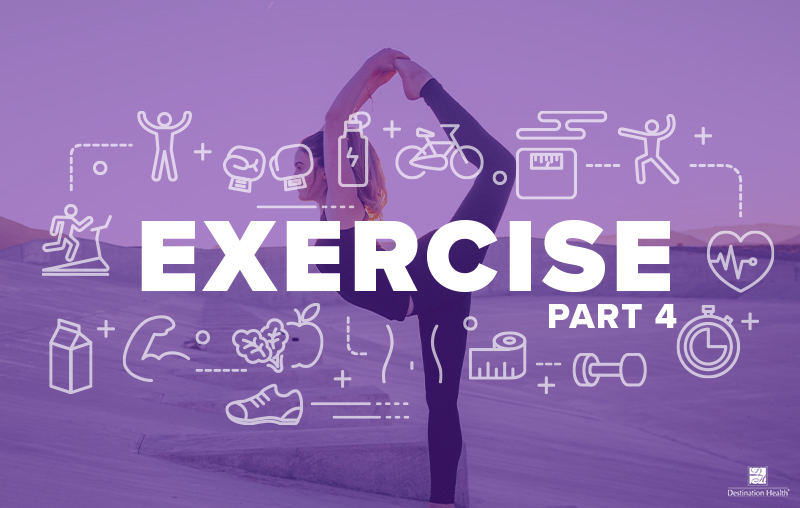PART IV: FLEXIBILITY
Written by Dr. Carl DuCharme
Many people simply don’t know the health benefits associated with flexibility and therefore, forget to include stretching when performing exercise. Improved flexibility leads to better mobility, posture, range of motion, decreases joint stress and risk of musculoskeletal injury. Stretching is the most common way to improve flexibility. Many types of stretching exist. For our purposes we will keep things simplified and focus on dynamic and isolated stretching styles.
Dynamic Stretching
Is performed by moving through your range of motion as you stretch. It usually involves transitioning from one body movement to another. Many people use this type of stretching to improve mobility. It is also a good way to warm prior to exercise. Think of doing arm circles prior to performing chest press or walking lunges before lower body exercise.
Isolated Stretching
This is the standard type of stretching most of us were taught as a child in school or athletics. It is when you slowly move a muscle to the end of its range of motion and hold it there for a period of time. Often it is performed a few times with a short rest period in between stretches. Think of bending forward at the waist to touch your toes and holding it for several seconds before returning to a standing position. This type of stretching is best performed after exercising when your muscles are warmed up in order to maximize benefits. There are various styles of isolated stretching. A common one is called Active Isolated Stretching (AIS). This style only holds the stretch briefly (2 seconds) and is thought to target the muscle and nearby myofascial tissues in a more efficient manner.
Perhaps the best way to become more flexible is by performing a combination of both isolated and dynamic styles. The two most well-known forms of exercise that accomplish this are yoga and Pilates. Both will improve flexibility, body control, muscular endurance and strength. The biggest key difference is yoga incorporates mind, body and spirit into exercise using meditation and breathing techniques. However, there is a lot of crossover between the yoga and Pilates. Both can be relaxing or extremely physically challenging!
Specific Health Benefits
Active exercise therapies like Pilates have been shown to be more effective in treatment of non-specific chronic low back pain than other forms of treatment like passive physiotherapy, ultrasound, hot and cold therapy and hands-off treatments.
A 2020 study reports that muscle stretching exercises are an effective way to reduce arterial stiffness, heart rate, diastolic blood pressure and improve vascular endothelial function in middle-aged and older adults. This is good news because all of these things can increase the risk of cardiovascular disease which is the leading cause of death in the U.S.
Fibromyalgia is a debilitating condition causing widespread muscle pain and tenderness. It is very difficult to treat and one of the mainstays of treatment involves exercise prescription. In 2017, this study found muscle stretching exercises to be beneficial in improving quality of life, physical function and pain in patients suffering from fibromyalgia. Therefore, recommendations to treat fibromyalgia should include stretching in addition to traditional aerobic and resistance training treatment plans.
Another interesting fact is that stretching can improve chronic insomnia. Stretching was also found to improve cognitive function and mood in physically active adults.
Let’s review the benefits of improving flexibility:
- Decreases risk of injury
- Improves mobility and range of motion
- Decreases joint stress
- Lowers blood pressure and heart rate
- Treats fibromyalgia and insomnia
- Improves mood and cognitive function
PLAN INTO ACTION
As stated above, there are so many benefits to improving flexibility we should make it a priority to incorporate stretching into our daily lives. If you already exercise a few days per week the simplest way to incorporate it into your exercise program is prior to your exercise. A quick dynamic stretching routine will help loosen up your joints and warm up your muscles prior to whatever your workout entails. This is an example of a total body warmup by Athlean-XX For Women that incorporates dynamic stretching.
If you prefer to stretch after you exercise, this is a poster that guides you through 5 upper body and 5 lower body isolated stretches. Remember, the best time to perform isolated stretching is when your muscles are already warm and after you exercise.
For those of you that are looking to take your fitness and flexibility to another level I highly recommend performing yoga or Pilates 2-3 times weekly. There are several apps you can download to your phone that offer on-demand or live sessions. Of course, you can always join a real studio or gym that offers live classes as well. Performing yoga or Pilates will help you put an emphasis on flexibility, body control and core strengthening.
Health Tip
While flexibility is important, I would not prioritize performing stretching over resistance training or aerobic exercise if you have limited time. This is because there are many more profound health benefits associated with resistance training and aerobic exercise as compared to those received from stretching.
The next blog post is the 5th and final blog of the Exercise Series. It will discuss the importance of maintaining balance as we age. Stay tuned!


